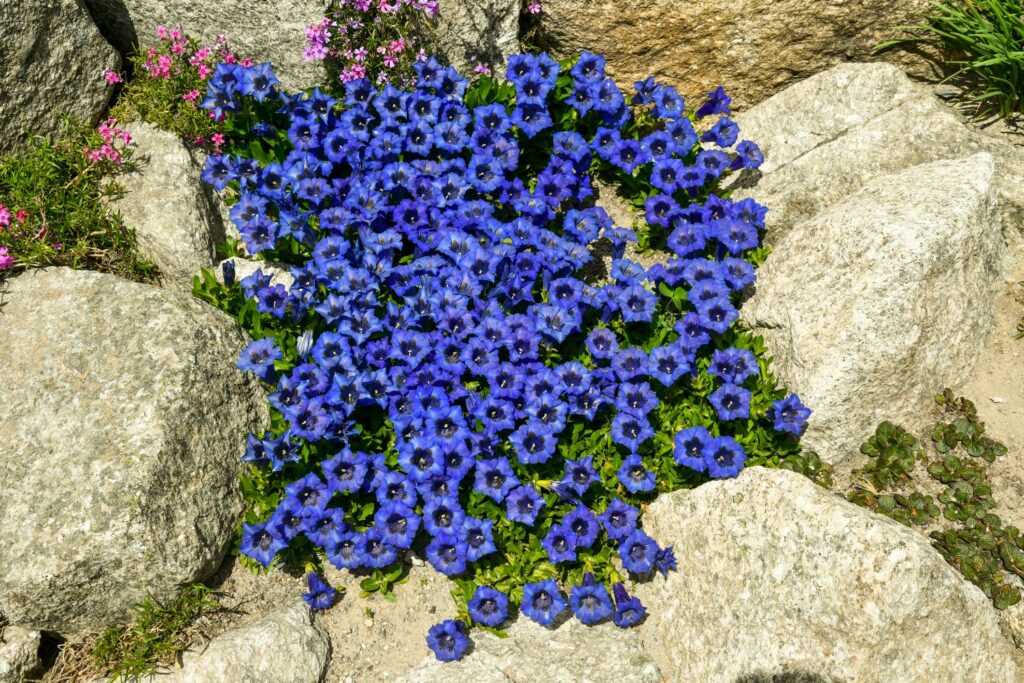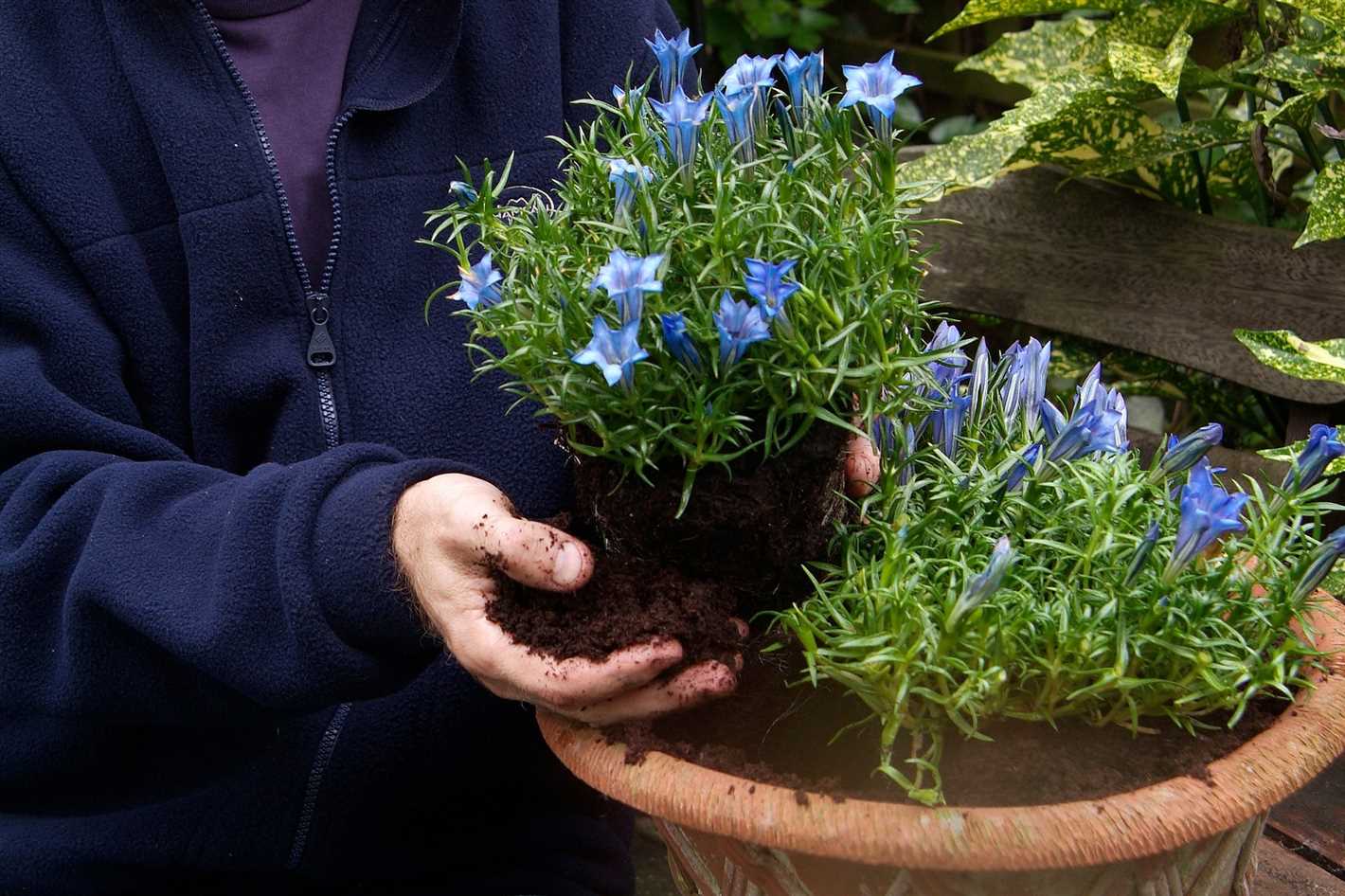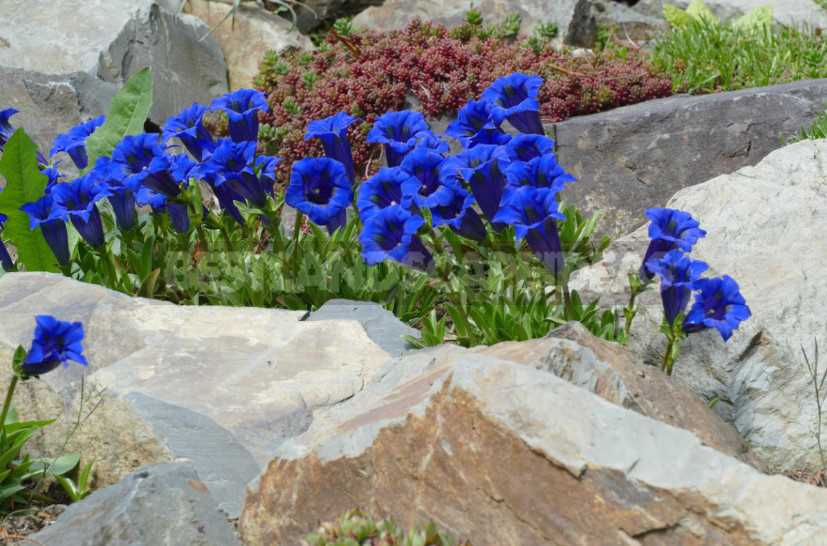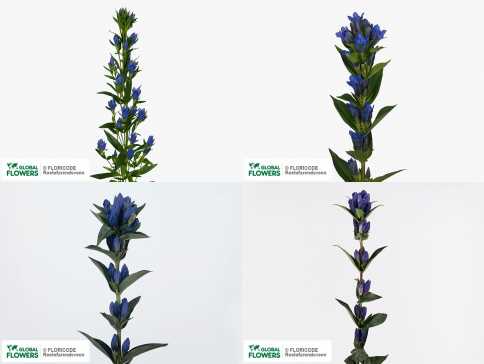- Gentian: Cultivation and Care in the Garden, Species and Varieties
- Cultivation
- Care
- Species and Varieties
- Choosing the Right Location for Gentian
- Sunlight
- Soil
- Moisture
- Temperature
- Protection
- Soil Preparation for Gentian
- 1. Soil Type
- 2. Soil Testing
- 3. Organic Matter
- 4. Drainage
- 5. Nutrient Amendments
- 6. Mulching
- 7. Watering
- 8. Maintenance
- 9. Crop Rotation
- Planting Gentian: Step-by-Step Guide
- 1. Choose the Right Location
- 2. Prepare the Soil
- 3. Dig the Planting Hole
- 4. Plant the Gentian
- 5. Add Mulch
- 6. Water and Care
- 7. Provide Winter Protection
- Watering and Fertilizing Gentian
- Watering
- Fertilizing
- Gentian Diseases and Pests: Prevention and Control
- Common Diseases
- Common Pests
- Integrated Pest Management
- Propagation of Gentian: Methods and Tips
- 1. Division
- 2. Seed Propagation
- 3. Tissue Culture
- Popular Species and Varieties of Gentian
- Gentiana acaulis
- Gentiana septemfida
- Gentiana lutea
- Gentiana dahurica
- Questions and Answers:
- What is Gentian?
- How do I grow Gentian in my garden?
- What are some popular species of Gentian?
- Can I grow Gentian from seeds?
- How long does it take for Gentian plants to bloom?
- Videos: Royal Blues – tales of some special Gentians
Gentian is a beautiful flowering plant that is highly prized for its vibrant blue flowers. It is a popular choice for gardeners looking to add color and elegance to their outdoor spaces. With proper cultivation and care, gentians can thrive in a variety of garden settings, from borders and rock gardens to woodland areas and containers.
There are many species and varieties of gentian to choose from, each with its own unique characteristics and growing requirements. Some popular species include the Gentiana sino-ornata, with its striking blue and white flowers, and the Gentiana acaulis, which is known for its dwarf size and early bloom time. Other popular varieties include the Gentiana paradoxa, with its yellow flowers, and the Gentiana septemfida, which has pink or purple flowers.
When it comes to cultivation and care, gentians prefer cool climates and well-drained soil. They should be planted in a location that receives partial sun to full shade, depending on the species. The soil should be slightly acidic and rich in organic matter. It is important to water gentians regularly, especially during dry periods, to keep the soil evenly moist but not waterlogged.
In terms of maintenance, gentians are relatively low-maintenance plants. They do not require much pruning, although deadheading spent flowers can encourage additional blooms. It is also important to protect gentians from pests, such as slugs and snails, which can be a common problem. Overall, with the right care, gentians can be a stunning addition to any garden.
Gentian: Cultivation and Care in the Garden, Species and Varieties
Gentians are beautiful and vibrant flowering plants that can add a touch of elegance to any garden. With their stunning blue or purple flowers, they are a popular choice among gardeners. Cultivating and caring for gentians in your garden can be a rewarding experience, but it requires some knowledge and attention.
Cultivation
Gentians thrive in cool temperate climates and prefer full sun or partial shade. They require well-drained soil that is rich in organic matter. Before planting, it is important to prepare the soil by loosening it and removing any weeds or stones. Gentians should be planted in the spring or fall, and spacing between plants should be about 6-12 inches.
When planting gentians, make sure to dig a hole that is big enough to accommodate the root ball. Place the plant in the hole and backfill with soil, making sure that the crown is at ground level. Gently firm the soil around the plant and water well.
Care
Proper care is essential for the health and longevity of gentians. Here are some tips to keep in mind:
- Watering: Gentians require regular watering, especially during dry spells. However, it is important not to overwater, as this can lead to root rot. Water the plants at the base to minimize wetting the foliage.
- Fertilization: Gentians benefit from regular fertilization to promote healthy growth and flowering. Use a balanced fertilizer with equal amounts of nitrogen, phosphorus, and potassium. Apply the fertilizer in early spring and again in mid-summer.
- Pruning: After the flowering season, you can trim back the plants to maintain their shape and promote bushy growth. Remove any dead or damaged foliage throughout the year to keep the plants looking their best.
- Protection: Gentians are susceptible to slugs and snails, so it is important to protect them from these pests. Use slug pellets or other organic pest control methods to keep them at bay.
Species and Varieties
Gentians belong to the Gentiana genus, which includes a wide variety of species. Here are some popular species and varieties:
| Species/Variety | Description |
|---|---|
| Gentiana acaulis | Low-growing species with deep blue flowers. Ideal for rock gardens or borders. |
| Gentiana sino-ornata | Medium-sized species with violet-blue flowers that have white interiors. Adds a pop of color to the garden. |
| Gentiana asclepiadea | Tall species with blue or purple flowers. Best suited for larger gardens or wildflower meadows. |
| Gentiana septemfida ‘Lagodechiana’ | Vigorous variety with purple flowers and a compact growth habit. Looks stunning in containers or as a border plant. |
These are just a few examples of the many beautiful gentian species and varieties available. Each has its own unique characteristics and requirements, so be sure to choose the ones that best suit your garden and climate.
Choosing the Right Location for Gentian
Gentians are beautiful and delicate flowering plants that require specific conditions to thrive. When choosing a location for your gentians, keep the following factors in mind:
Sunlight
- Gentians prefer partial shade to full sun.
- They can tolerate morning sun, but direct afternoon sun can be too intense.
- If you are planting gentians in a hot climate, choose a location where they will receive shade during the hottest part of the day.
Soil
- Gentians grow best in well-drained soil that is rich in organic matter.
- A slightly acidic soil pH between 5.5 and 6.5 is ideal for these plants.
- Ensure that the soil is not compacted, as gentians have shallow root systems that can suffer from poor drainage.
Moisture
- Gentians require consistent moisture, but they cannot tolerate waterlogged soil.
- Choose a location where the soil retains moisture without becoming soggy.
- Consider planting gentians near a water source or in a spot that receives regular rainfall.
Temperature
- Gentians are cold-hardy plants that can tolerate frost.
- However, they prefer cooler temperatures between 50°F and 60°F (10°C and 15°C).
- Avoid planting gentians in locations with extreme heat or significant temperature fluctuations.
Protection
- Gentians can be susceptible to strong winds, which can damage their delicate blooms.
- Choose a location that offers some protection from strong winds, such as near a fence or other structures.
By considering these factors and choosing the right location for your gentians, you can create an optimal environment for their growth and enjoy their beautiful blooms for years to come.
Soil Preparation for Gentian
1. Soil Type
Gentians prefer well-drained soil that is rich in organic matter. They thrive in slightly acidic to neutral soil with a pH range of 5.5 to 7.0. Heavy clay or compacted soils should be amended to improve drainage and aeration.
2. Soil Testing
It is recommended to perform a soil test to determine the nutrient levels and pH of your soil. This will help you identify any deficiencies or imbalances and allow you to make appropriate amendments.
3. Organic Matter
Add organic matter, such as compost or well-rotted manure, to the soil prior to planting gentians. This will improve the soil structure, moisture retention, and nutrient content. Incorporate the organic matter into the top 6 to 8 inches of soil.
4. Drainage
Ensure proper drainage by loosening the soil and breaking up any compacted areas. If the soil is heavy clay or poorly drained, consider raising the planting area by creating a raised bed or adding drainage materials such as gravel or sand.
5. Nutrient Amendments

Based on your soil test results, you may need to amend the soil with additional nutrients. For example, if your soil is deficient in phosphorus, you can add bone meal or rock phosphate. Follow the recommendations provided by the soil test or consult with a local gardening expert.
6. Mulching
After planting gentians, apply a layer of organic mulch around the plants to suppress weeds and conserve moisture. Use materials such as wood chips, straw, or shredded bark. Avoid piling mulch directly against the stems of the plants.
7. Watering
Proper watering is essential for gentians, as they require consistent moisture. Ensure the soil is evenly moist but not waterlogged. Avoid overhead watering, as it can cause fungal diseases. Consider using drip irrigation or a soaker hose to deliver water directly to the root zone.
8. Maintenance
Regularly monitor the soil moisture levels and adjust your watering schedule accordingly. Gentians may require additional watering during dry periods. Also, monitor the soil pH and make adjustments if necessary to maintain the ideal pH range for your gentians.
9. Crop Rotation
To prevent disease buildup and ensure long-term plant health, practice crop rotation. Avoid planting gentians in the same location every year. Rotate them with other unrelated plant species to reduce the risk of soil-borne diseases.
Planting Gentian: Step-by-Step Guide
1. Choose the Right Location
Gentians prefer cool and moist environments, so choose a planting location that receives partial shade or bright indirect light. Avoid areas with full sun, as it can scorch the delicate flowers and foliage.
2. Prepare the Soil
Gentians require well-draining soil with a slightly acidic to neutral pH level. Before planting, loosen the soil in the planting area to a depth of about 6-8 inches. Remove any weeds and debris, and incorporate compost or peat moss to improve drainage and add organic matter.
3. Dig the Planting Hole
Dig a hole that is slightly larger and deeper than the root ball of the gentian plant. This will allow the roots to spread out and establish themselves more easily. Ensure that the hole is deep enough to allow the crown of the plant to sit level with or slightly above the soil surface.
4. Plant the Gentian
Place the gentian plant in the prepared hole, making sure that the crown is level with or slightly above the soil surface. Gently backfill the hole with soil, firming it around the roots to remove any air pockets. Water the newly planted gentian thoroughly to settle the soil.
5. Add Mulch
Apply a 2-3 inch layer of organic mulch around the base of the gentian plant. This will help to conserve moisture, regulate soil temperature, and suppress weed growth. Avoid covering the crown of the plant with mulch, as this can lead to rot.
6. Water and Care
Water the gentian regularly, keeping the soil consistently moist but not waterlogged. Gentians can be sensitive to drought, so monitor the moisture level and adjust watering as needed. Avoid overhead watering, as this can cause disease. Fertilize the plants once or twice during the growing season with a balanced, slow-release fertilizer.
7. Provide Winter Protection
In colder climates, provide winter protection for gentian plants by applying a layer of mulch or straw around the base of the plants. This will help to insulate the roots and protect them from freezing temperatures. Remove the winter protection in the spring once the danger of frost has passed.
Following these step-by-step instructions will help ensure the successful planting and care of gentian plants in your garden. With their vibrant, showy flowers and unique foliage, gentians add a touch of beauty and elegance to any landscape.
Watering and Fertilizing Gentian
Watering
Gentians are moisture-loving plants that require consistent watering to thrive. It is important to keep their soil evenly moist throughout the growing season, especially during hot and dry periods. However, ensure that the soil is well-draining to prevent waterlogged conditions, which can be detrimental to gentians.
Watering should be done deeply, allowing the water to penetrate the root zone. A general guideline is to water the plants once or twice per week, depending on the weather conditions. During periods of active growth and flowering, increase the frequency of watering to prevent the soil from drying out.
During the winter dormancy period, reduce watering and only water the plant when the soil feels dry to the touch. Overwatering during this period can cause root rot.
Fertilizing
Gentians are not heavy feeders, but they benefit from occasional fertilization to promote healthy growth and abundant flowering. A balanced, slow-release fertilizer can be applied in early spring when new growth begins.
Use a fertilizer with a lower nitrogen content to prevent excessive foliage growth at the expense of flowering. Follow the manufacturer’s instructions for the correct application rate.
Avoid over-fertilizing gentians, as this can lead to weak and leggy growth. Monitor the plants throughout the growing season and adjust the fertilization schedule accordingly.
It is also beneficial to amend the soil with organic matter, such as compost or well-rotted manure, before planting gentians. This improves soil fertility and drainage.
Gentian Diseases and Pests: Prevention and Control

Gentians are generally resistant to diseases and pests, but there are a few common issues that can affect their health. By adopting preventive measures and appropriate control methods, you can keep your gentians healthy and thriving.
Common Diseases
- Root Rot: Root rot is a fungal disease that can affect gentians if they are overwatered or planted in poorly-drained soil. To prevent root rot, ensure that the soil is well-drained and water the plants moderately.
- Leaf Spot: Leaf spot is a fungal disease that causes dark spots on the leaves. To prevent leaf spot, avoid overhead watering, as wet leaves create a favorable environment for the fungus. If leaf spot occurs, remove the affected leaves and apply a fungicide if necessary.
- Powdery Mildew: Powdery mildew is a fungal disease that appears as a powdery white coating on the leaves. To prevent powdery mildew, keep the plants in an area with good air circulation and avoid overcrowding. You can also apply a fungicide if the disease becomes severe.
Common Pests
- Aphids: Aphids are small insects that suck sap from the plants, causing stunted growth and distorted leaves. To control aphids, you can spray the plants with a strong jet of water to dislodge them or use insecticidal soap.
- Slugs and Snails: Slugs and snails are common pests that feed on gentian leaves, leaving behind holes and slime trails. To control slugs and snails, you can handpick them from the plants or use organic slug pellets.
- Thrips: Thrips are small, slender insects that feed on gentian flowers, causing them to become distorted and discolored. To control thrips, you can use insecticidal soap or predatory insects like lacewings or ladybugs.
Integrated Pest Management
Implementing an integrated pest management (IPM) strategy can help prevent and control diseases and pests in your gentian garden. IPM involves a combination of cultural, biological, and chemical control methods to maintain a healthy plant environment.
| Control Method | Description |
|---|---|
| Cultural Control | Practices such as proper plant spacing, good soil drainage, and regular inspection can help prevent and manage diseases and pests. |
| Biological Control | Introducing beneficial insects or predators that feed on pests can help control their populations naturally. |
| Chemical Control | If necessary, use targeted insecticides or fungicides to control diseases and pests. Always follow the instructions on the label and use chemical control as a last resort. |
By being proactive and implementing proper prevention and control measures, you can keep your gentians healthy and free from diseases and pests.
Propagation of Gentian: Methods and Tips

Gentian is a beautiful flowering plant that can be propagated by various methods. Here are some common methods and tips for propagating gentian:
1. Division
One of the easiest methods of propagating gentian is through division. This method is best done in the spring or early fall when the plant is not actively growing. To propagate through division, follow these steps:
- Carefully dig up the mature gentian plant.
- Divide the plant into smaller sections, making sure each section has roots and healthy shoots.
- Replant the divided sections in well-draining soil, spacing them apart to allow room for growth.
- Water the newly planted sections thoroughly and keep the soil moist until they establish.
2. Seed Propagation
Another method of propagating gentian is through seeds. Here’s how to propagate gentian from seeds:
- Collect mature seeds from a healthy gentian plant.
- Prepare a seed tray or small pots with a well-draining potting mix.
- Moisten the potting mix and sow the gentian seeds on the surface, lightly pressing them into the soil.
- Cover the tray or pots with a clear plastic wrap or place them in a propagator to create a humid environment.
- Place the tray or pots in a bright, indirect light location, avoiding direct sunlight.
- Keep the soil consistently moist but not waterlogged.
- Once the seedlings have grown to a suitable size, transplant them into individual pots or the garden.
3. Tissue Culture

Tissue culture is a more advanced method of propagating gentian but can yield a large number of plants with desired characteristics. This method is usually done in a laboratory by plant biologists. Here’s a brief overview of the tissue culture process:
- Collect a small section of plant tissue, such as a leaf or a stem.
- Disinfect the tissue to remove any potential contaminants.
- Culture the tissue in a nutrient-rich medium containing plant hormones.
- Allow the tissue to grow and develop into a new plantlet.
- Transplant the plantlets into pots or the garden once they are well-established.
Propagation of gentian can be a rewarding process, allowing you to expand your collection or share these beautiful plants with others. Whether you choose division, seed propagation, or tissue culture, following these methods and tips will help increase your success rate. Happy propagating!
Popular Species and Varieties of Gentian
There are many different species and varieties of gentian available for cultivation in the garden. Here are some popular choices:
Gentiana acaulis
Common Name: Stemless Gentian
Description: This species of gentian is short and compact, growing to a height of about 4-6 inches. It produces vibrant blue flowers that bloom in early spring.
Gentiana septemfida

Common Name: Crested Gentian
Description: The Crested Gentian is a taller variety, reaching heights of about 12-18 inches. It has blue flowers with a white center, creating a striking contrast. This species blooms in late summer and early fall.
Gentiana lutea
Common Name: Yellow Gentian
Description: As the name suggests, this species of gentian produces beautiful yellow flowers. It grows to a height of about 2-3 feet and blooms in late summer and early fall. Yellow Gentian is known for its medicinal properties and is used to make a variety of herbal remedies.
Gentiana dahurica
Common Name: Dahurian Gentian
Description: The Dahurian Gentian is a hardy species that is native to East Asia. It has bright blue flowers that bloom in summer. This gentian can tolerate a wide range of soil conditions and is a good choice for beginners.
These are just a few examples of the wide variety of gentian species and varieties that can be grown in the garden. Each has its own unique characteristics and requirements, so make sure to choose the ones that are best suited to your climate and growing conditions.
Questions and Answers:
What is Gentian?
Gentian is a genus of flowering plants that belongs to the family Gentianaceae. It includes more than 400 species, and they are known for their vibrant blue flowers.
How do I grow Gentian in my garden?
To grow Gentian in your garden, you need to provide well-drained soil with plenty of organic matter. Most Gentian species prefer full sun to partial shade. Water regularly, but be careful not to overwater as this can lead to root rot. You can divide and replant the plants every few years to keep them healthy.
What are some popular species of Gentian?
Some popular species of Gentian include Gentiana acaulis (stemless gentian), Gentiana lutea (yellow gentian), and Gentiana septemfida (creeping gentian). These species have beautiful flowers and can be a great addition to any garden.
Can I grow Gentian from seeds?
Yes, you can grow Gentian from seeds. However, it can be a bit challenging as Gentian seeds require a period of stratification to germinate. This means that they need to be exposed to cold temperatures for a certain period before they will sprout. It’s best to sow the seeds in fall and let them experience the natural cold of winter.
How long does it take for Gentian plants to bloom?
The time it takes for Gentian plants to bloom can vary depending on the species and growing conditions. In general, they can start blooming within one to two years after planting. Some species may take longer to establish and produce flowers.







